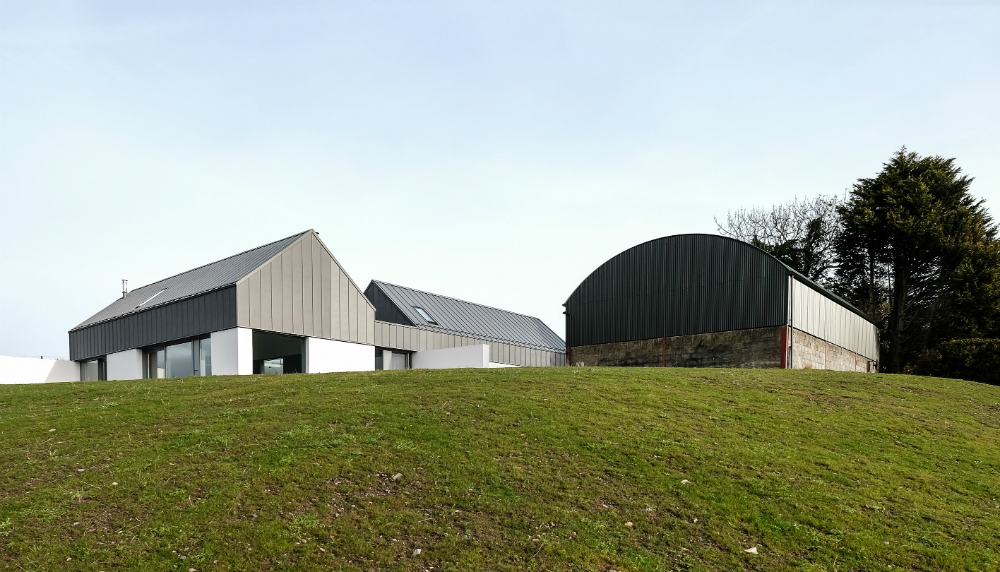This family home, built on the site of a small farmstead in County Down, Northern Ireland, used basic materials but a high level of attention to detail to create an outstanding quality building on a very modest budget. Designed by McGonigle McGrath Architects, with Hans Crosby as main contractor, it was winner of both the RIBA and Grand Designs House of the Year 2019 and was built on a JCT Intermediate Building Contract.
The brief for this project was to create a simple property to accommodate a semi-retired couple and their adult children, who were occasional visitors. Beyond providing a suitable home, a connection to place and the existing surroundings was a key requirement. The site, set on a small farmstead in the drumlins of County Down, Northern Ireland, contained an existing barn and shed with a double yard. The approach to the property, via an overgrown lane, conceals the enclosure created by the yards and the low walls, as the view of the drumlins beyond is predominant from the road.
Traditional Northern Ireland barns feature curved tops clad in corrugated steel, atop a simple masonry structure. The property echoes the barn in design, with its pitched roof resting on a brickbuilt structure. It comprises two simple elements, arranged in relation to both the existing barn and landscape. A more domestic scale is provided through material choice however, swapping the corrugated steel for a zinc roof and white-rendered concrete walls for the structure. The rooms are arranged within the two elements according to function and requirements for light, privacy, and view. The first element contains the bedrooms and is positioned so that it creates a sloping arrival yard and enclosed space to the rear. The second element is oriented to maximise the view and contains the larger living spaces, whose generous volumes echo the barn interior. Large windows are carefully positioned to frame views that connect the building to the landscape and courtyards. The window frames are embedded within the wall reveals to further convey the barn-like feeling of openness towards the landscape.
The link between the internal and external is reinforced by the line created where the roof and the walls meet. This not only provides a fixed point where walls and windows stop and roof begins, but also a consistent line, inside and out, between rooms and external spaces at different levels, helping to embed the building within the landscape.
The fact that the building structure and form has been derived from the language of the local agricultural landscape has enabled the project to be completed on a modest budget. Cheap materials, such as concrete and brick, and basic construction methods – the pitched roof and masonry construction for instance – enables cost to be kept at a minimum. Other cost saving measures include using large windows that are fixed throughout with openings for ventilation – a much more cost-effective option than moving windows or sliding glass doors.
Whilst materials and construction methods have been deliberately chosen to minimise budget, expense has not been spared in attention to detail and the quality of finishing, which is precise and restrained. The concrete blocks are rendered outside but painted inside with flush mortar joints to leave a perfect finish. The careful use of cheaper construction materials has opened the door for more options in the final look of the building – swapping steel for zinc in the roof for instance, or the use of terrazzo and robust joinery. This has further linked the house to its surroundings by maximising the craft and expertise of specialist local contractors.
House Lessans is an example of a project which simultaneously respects, reflects, and enhances its surrounding landscape. The physical embedding of the property within the site to reduce its impact from the road creates a quiet presence that opens up to the landscape beyond the yards formed in relation to the neighbouring barn. From its entrance, between the two functional living elements, either the view orientation or enclosed orientation can be accessed, consolidating the sense of place. The building successfully respects its history, surroundings, and function in its design and construction, but the quality and attention to details provide an appropriate and attractive domesticity which enhances its environment. The use of the JCT Intermediate Building Contract echoes this project theme, in providing a familiar contract on a traditional procurement method, that is also able to offer a range of options to cover complexity and consideration in design and construction.
House Lessans Project Data
Project Start – November 2017
Project Completion – April 2018
Floor Area – 235m²
Cost – £335,000
Contract – JCT Intermediate Building Contract
Client – Private
Architect – McGonigle McGrath
Main Contractor – Hans Crosby
Quantity Surveyor – MJ Donnelly Quantity Surveyors
Structural Engineer – MWL Consulting Engineers
Image: Aidan McGrath

